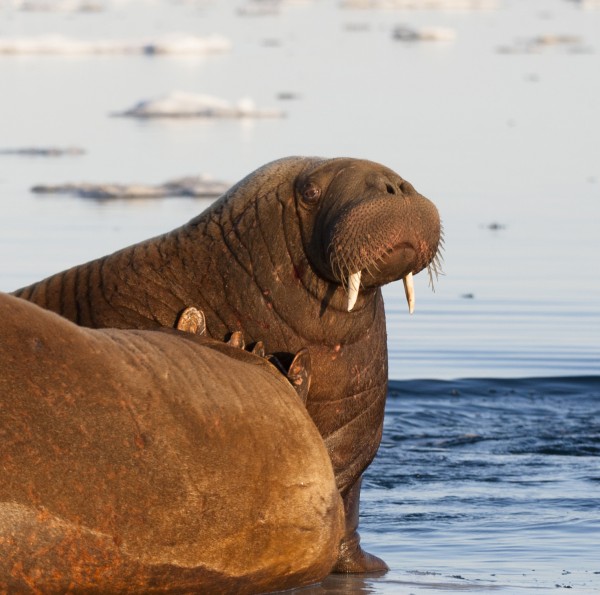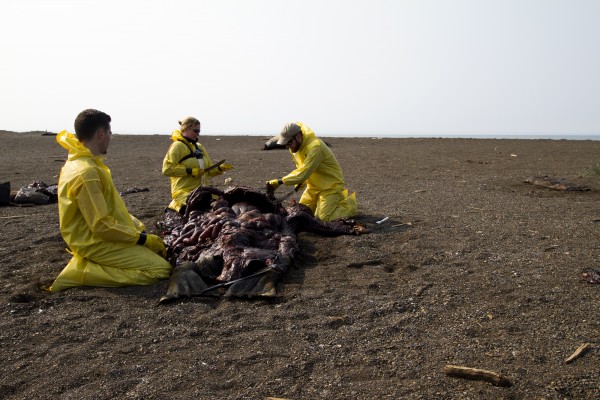Research gives insight into historic walrus population dynamics
October 13, 2015
Lauren Frisch
907-474-5022

Hormones stored in ancient bones are revealing how Pacific walrus populations react to environmental change.
Alaska’s oceans have already experienced changes in temperature, sea ice range and acidity driven by increasing atmospheric carbon dioxide concentrations. In an ecosystem that continues to change, scientists can look into the past to learn about the factors affecting walrus populations, and predict how walruses might respond to climate change in the coming years.
Identifying what puts stress on walrus populations is particularly important in Alaska because walruses are a subsistence resource for many coastal communities. The State of Alaska declared an economic disaster for Saint Lawrence Island in 2013 because there were so few walruses to hunt.
“Many subsistence hunters do not have the luxury of going to the supermarket,” said Lara Horstmann-Dehn, an associate professor at the University of Alaska Fairbanks School of Fisheries and Ocean Sciences. When walrus populations are low, hunting conditions are poor or the walruses have migrated to somewhere new, a major food source for the community disappears.
This research has practical applications for subsistence hunters reliant on stable populations. In years where there are no walruses to hunt, this research may reveal whether populations are low or the walruses are adapting to changes in the environment by changing feeding spots.
In addition, walruses are currently being considered as a candidate for listing under the U.S. Endangered Species Act. If selected, critical areas will be established around walrus feeding locations to reduce future harm to populations. Understanding where walruses feed now and where they are likely to feed as ocean environments change will enable better management to protect walrus populations.
Walruses like to eat bottom-dwelling critters, including clams and other mollusks, although when food is scarce they’ve been known to eat seals as well. They like to feed on continental shelves, where the water is shallow, making the abundance of food more accessible.
Pacific walrus populations live in the northern seas off the coasts of Russia and Alaska. The walruses can be found near Saint Lawrence Island in the Bering Sea in the winter. In the summer, female walruses migrate up to the Chukchi Sea, while male walruses migrate to the Bristol Bay area. They typically rest on sea ice between feeding trips. When the sea ice recedes, either the walruses must follow the sea ice or move to coastal areas where they can rest on land.

Horstmann-Dehn is working with a team of researchers, including UAF faculty members Nicole Misarti and Link Olson, to study samples of walrus bones spanning 3,000 years. The samples of bones come from the University of Alaska Museum of the North, the Smithsonian Institution, and middens, or old whaling dumps, off the coast of western Alaska. The research team collaborates with co-management groups, such as the Eskimo Walrus Commission, and has acquired some present-day bone samples by collecting alongside Native harvesters.
With funding from the National Science Foundation and the Bureau of Ocean and Energy Management, the researchers are studying walruses that lived through past warm and cold periods. “It is our hope that by learning more about how walruses were impacted by previous warming and cooling in the Arctic, we will help Alaska Native communities and co-management groups make informed and effective decisions about the management and conservation of walruses in an uncertain future,” said Casey Clark, an SFOS Ph.D. student working with Horstmann-Dehn.
They hope to discover the effect that variables like temperature and concentration of sea ice have on walrus populations and feeding location. “Our research looks at walrus diet, stress, reproductive and population changes throughout past times of Arctic warming,” said Patrick Charapata, an SFOS master’s student working with Horstmann-Dehn.
Charapata is studying how walrus hormone levels vary as climate fluctuates. Steroid hormones include both stress and sex hormones and are bound to fat. Even in ancient samples, marine mammal bones are fatty and provide a good source of steroid hormones.
At first, the researchers were not sure if they would be able to extract steroid hormones from such old samples. Horstmann-Dehn first got the idea for the extraction methods from forensics literature, where it is common to study hormones in disjointed bones to learn about the sex of the deceased. “It’s a bit gruesome and a bit CSI,” she said.

The extraction methods are straightforward. An organic solvent is used to separate fat, along with the hormones contained in the fat, from the bone. The process is used to extract hormones from hair, whiskers and bones in modern samples. The ability to successfully extract hormones from ancient samples gives this research a unique edge.
“We have extracted all the hormones we want to look at, including cortisol, estradiol, progesterone and testosterone from archaeological, historical and modern bone,” said Charapata. The next step is determining what the hormone trends may reveal about ancient populations.
For example, the researchers anticipate their results will reveal trends in walrus population size. Charapata is just starting to analyze hormone levels in the samples, but 1961 already stands out as a year with high levels of progesterone and estradiol, which are hormones usually associated with pregnancy. This might show walrus numbers rebounding after a population crash that began in the 1930s.
Clark is also looking for trends in ancient walrus populations. He is studying how elements in walrus teeth can help map out common feeding areas. He’s looking at a number of elements, including cadmium, copper, iron, manganese, and strontium. Teeth grow yearly rings, similar to tree rings. The concentrations of elements in each year’s ring reflect concentrations of elements in the water where the animal was feeding that year.
Using the record from these ancient teeth, Horstmann-Dehn and Clark hope to learn more about where walruses fed in the past, and if feeding locations have changed over time. Clark is starting to consider what changes in elements could reveal about walrus migration patterns. He plans to cluster animals based on similar elemental concentrations, and study cyclical changes in elements across growth layers. “With some thought and analysis we hope to be able to differentiate between animals that spent the majority of their time in different regions,” Clark said.
The results of these simultaneous projects will help local decision-makers prepare for and adapt to future periods when walrus populations are low. The results may also suggest conservation efforts or management decisions that can be made to preserve walrus populations in the future. Initial results of the project have already been shared with residents on Saint Lawrence Island, Barrow, Point Lay and Dillingham, and the researchers will continue sharing results as the project moves forward.
ADDITIONAL CONTACTS: Lara Horstmann-Dehn, 907-474-7724, lara.horstmann@alaska.edu


